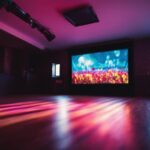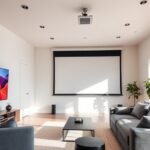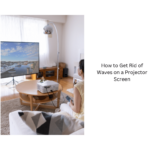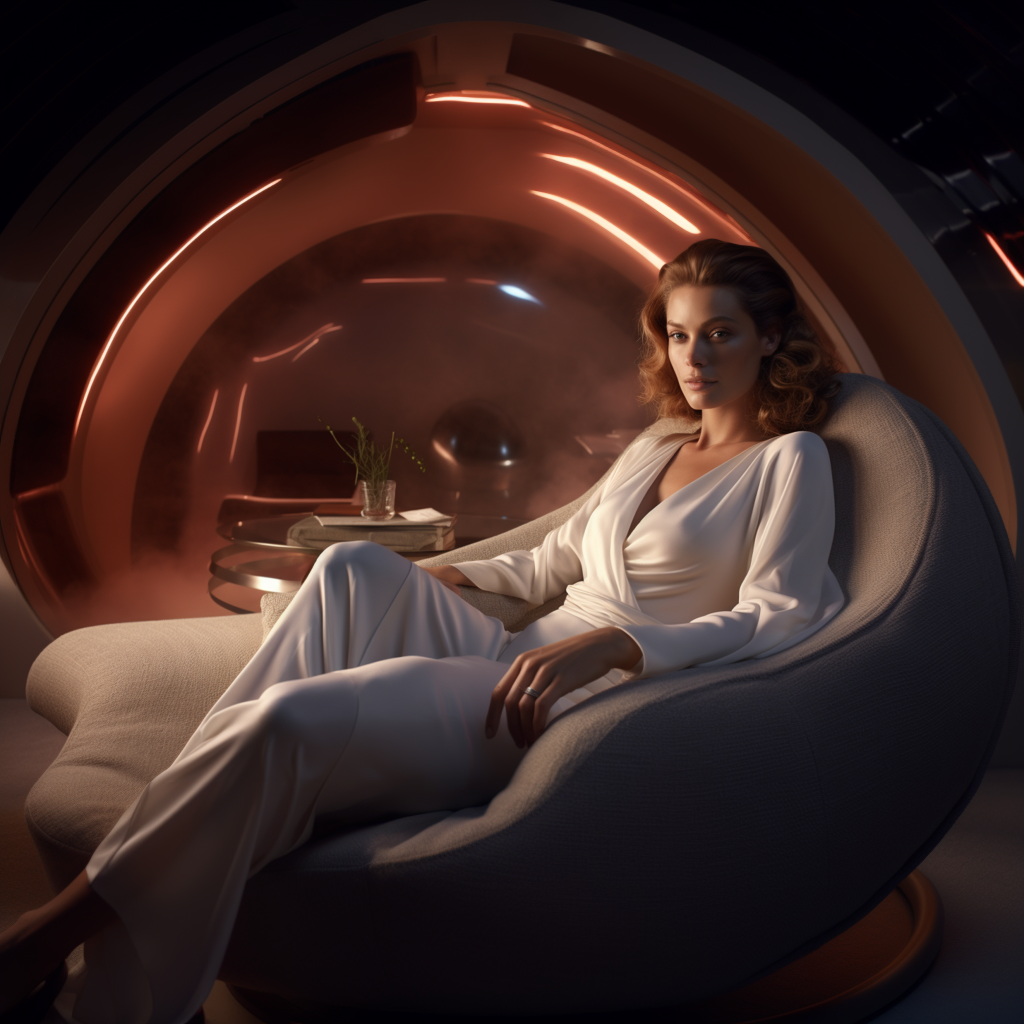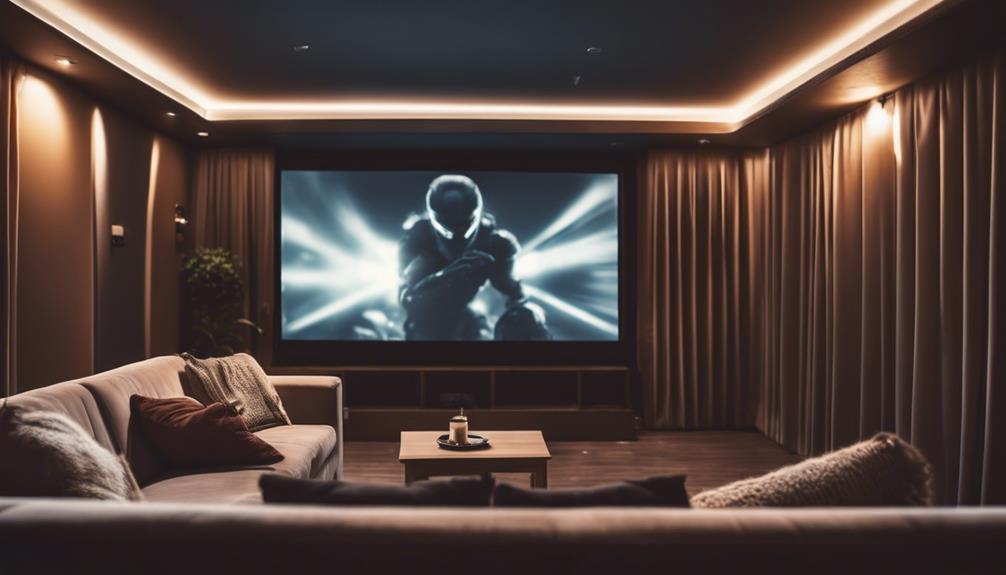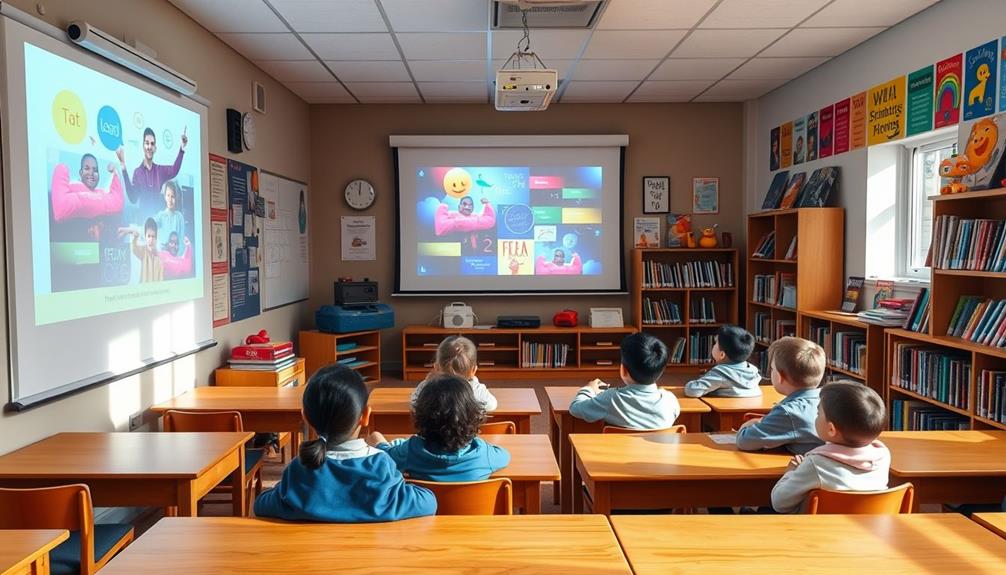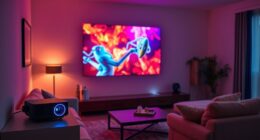Understanding projector screen gain is essential for enhancing your viewing experience. Gain measures how much light the screen reflects; high-gain screens (over 1.0) brighten images, perfect for well-lit spaces, while low-gain screens (under 1.0) improve color accuracy in darker rooms. Consider factors like ambient light and your projector's brightness when selecting a screen. Neutral gain screens (1.0) offer a balance for various environments. Keep in mind the viewing angles and screen materials, as these impact overall quality. With the right choice, you'll maximize your setup's potential. Explore further to discover detailed tips on finding your ideal screen.
Key Takeaways
- Screen gain measures light reflection, impacting brightness; high gain screens enhance brightness in bright rooms, while low gain screens improve color accuracy in dark environments.
- Low gain screens (0.5 to 0.9) are ideal for home theaters, providing uniform images with high brightness projectors (over 3000 lumens).
- Neutral gain screens (1.0) balance brightness and color fidelity, suitable for moderate ambient light and medium brightness projectors (2000-3000 lumens).
- High gain screens (1.1 to 2.5) excel in bright environments, enhancing vividness but may cause uneven image quality from off-angles.
- Consider screen material, viewing angles, and projector brightness when selecting a screen for optimal viewing experience.
Understanding Screen Gain

When it comes to choosing a projector screen, understanding screen gain is vital. Screen gain measures how effectively a projector screen reflects light, quantified as a ratio against a perfect reflective surface, which has a gain of 1.0. A high-gain screen, with a gain greater than 1.0, reflects more light, making your images appear brighter. This can considerably enhance projector performance, especially in brightly lit rooms.
Conversely, low-gain screens have a gain of less than 1.0, reducing brightness but often improving color accuracy and uniformity.
The gain of your screen directly influences the perceived brightness of the projected image. For instance, a screen with a gain of 1.5 can make a 1,000-lumen projector look like it's producing 1,500 lumens.
Different screen materials also play a vital role; matte screens typically offer lower gain, while reflective coatings can achieve higher gain values.
When selecting a projector screen, consider your room lighting conditions and how much brightness you need. By understanding screen gain, you can choose the right screen to optimize your projector's performance for the best viewing experience.
Types of Screen Gain

When choosing a projector screen, you'll encounter three main types of screen gain: low, neutral, and high.
Each type has its strengths depending on your room's lighting and your projector's brightness.
Understanding these options helps you make the right choice for your viewing experience.
Low Gain Screens
Low gain screens are an excellent choice for those looking to create a cinematic experience in dark environments. With a gain value ranging from 0.5 to 0.9, these screens excel in controlled lighting conditions, minimizing light reflection and ensuring that the images remain uniform. This means you'll enjoy vibrant visuals without the distraction of glare or hot spots.
If you're using low gain screens, pairing them with a high brightness projector (over 3000 lumens) is essential. Since these screens typically have a lower brightness output, they can appear dim in spaces with significant ambient light, making them less suitable for well-lit areas.
The matte white materials used in low gain screens not only provide a neutral gain but also maintain color accuracy, enhancing your viewing experience.
Neutral Gain Screens
For those seeking a balanced viewing experience, neutral gain screens offer a gain value of 1.0, reflecting light evenly and maintaining color accuracy.
These versatile screens are ideal for home theaters where you have controlled light conditions. They guarantee consistent image quality, providing the brightness and clarity you want without distorting colors.
While neutral gain screens excel in low ambient light environments, they're less effective in bright rooms compared to high gain screens.
However, they do shine when used with projectors that have medium brightness, typically between 2000-3000 lumens. This combination optimizes image clarity and detail, preserving the color fidelity that enhances your viewing experience.
Another advantage of neutral gain screens is their ability to maintain quality across a wider viewing angle.
This makes them perfect for group viewings, allowing everyone in the room to enjoy the same vibrant visuals regardless of their seating position.
High Gain Screens
While neutral gain screens are great for controlled environments, high gain screens are designed to excel in spaces with significant ambient light. With a gain value ranging from 1.1 to 2.5, these screens reflect more light back to you, resulting in brighter and more vivid images. This feature enhances your viewing experience in settings like conference rooms or well-lit living areas.
However, be aware that high gain screens can create hot spots—areas of excessive brightness—when viewed from off-angles, which may lead to uneven image quality. The screen material, often made from glass beads or specific reflective coatings, is vital for increasing light reflection but can also impact color accuracy.
For best performance, it's important to pair high gain screens with projectors that have higher brightness outputs, ideally over 3000 lumens. This combination helps prevent image washout in bright conditions, ensuring you get the most out of your setup.
If you're in a bright environment and need vibrant images, high gain screens could be the right choice for you, just keep in mind their potential drawbacks.
Measuring Screen Gain

To measure screen gain effectively, you'll need some essential tools like a light meter and a tape measure.
You can use specific techniques to project a test pattern and gather accurate readings from different points on the screen.
Once you've collected your data, calculating the gain becomes straightforward, helping you assess the screen's performance.
Tools for Measurement
Accurate measurement of projector screen gain requires several vital tools to guarantee reliable results. First and foremost, a light meter is fundamental for measuring the amount of reflected light from your projector screen compared to a standard reference screen. This device allows you to assess the screen's performance regarding brightness.
Next, you'll want to project a test pattern onto the screen. This establishes a baseline for your measurements and guarantees consistent results during gain calculations.
Don't forget to note the distance between the projector and the screen, as it affects your brightness readings and, consequently, the gain calculation.
To quantify screen gain, use the formula: Screen Gain = Brightness on Perfect Surface (1.0) / Brightness on Screen. This calculation helps you understand how well your screen reflects light.
Additionally, measuring reflected light at various points on the screen is vital. This will help you determine the Half Gain Viewing Angle, indicating where brightness drops to 50%.
With these tools, you're well-equipped to accurately measure your projector screen's gain and make informed decisions.
Measuring Techniques
Measuring screen gain effectively requires a systematic approach to guarantee you capture accurate data.
Using the right measuring techniques is vital for evaluating how well your screen performs in different conditions. Here are three key steps to follow:
- Set Up Your Projector: Position your projector at the recommended distance from the screen based on its size. This maintains ideal light reflection and accurate brightness measurement.
- Utilize a Light Meter: Equip yourself with a light meter to quantify the amount of reflected light from the screen. This device will help you gauge the screen gain by measuring brightness at various points.
- Conduct Uniformity Measurements: Take readings across the screen, noting that the center usually displays maximum brightness compared to the edges.
Pay attention to the Half Gain Viewing Angle, as it helps determine ideal viewing positions where brightness remains consistent.
Calculation Methodology
When you're ready to calculate screen gain, you'll need to follow a straightforward methodology to guarantee reliable results.
Start by setting up a movie projector to display a test pattern on your projector screen. Make sure everything's properly aligned and leveled for accurate measurements.
Next, use a light meter to assess the brightness of the reflected light from your screen, comparing it to a standard reference screen made of barium sulfate or magnesium carbonate, which has a gain of 1.0.
Measure the distance between the projector and the screen with a tape measure, as this distance can greatly affect your brightness readings.
To calculate the screen gain, divide the brightness measured on your screen by the brightness reflected from the standard reference screen.
Don't forget to assess the half gain viewing angle, which reveals where the brightness drops to 50% of the maximum level.
This information is vital for understanding how your screen performs at different viewing angles, ensuring you achieve the ideal viewing experience, no matter where you sit.
Following this calculation methodology will help you make informed decisions about your projector screen choice.
Factors Affecting Screen Gain

Understanding the factors that affect screen gain is essential for making the right choice for your projection needs. Several elements play a significant role in determining how well your screen performs:
- Screen Material: The type of material you choose impacts gain. Matte white offers neutral gain, while glass-beaded surfaces enhance brightness for high gain screens.
- Ambient Light: In brighter environments, high gain screens can help maintain image quality. Conversely, low gain screens work better in dark rooms to prevent overexposure.
- Viewing Angles: High gain screens provide a narrow sweet spot for ideal image quality, while low gain screens allow for wider viewing angles without sacrificing brightness consistency.
Additionally, consider projector brightness. Low brightness projectors (under 2000 lumens) pair well with high gain screens (1.5 to 2.5), which enhance visibility.
On the other hand, high brightness projectors (over 3000 lumens) typically work best with low gain screens (0.8 to 1.0) to guarantee peak performance.
Ideal Gain for Different Environments

Choosing the ideal gain for your projector screen hinges on the environment where it'll be used.
In home theaters with controlled lighting, low gain screens (0.8-1.0) are perfect. They enhance color accuracy and maintain brightness, providing a cinematic experience in dark rooms by preserving image quality.
For spaces with moderate ambient light, a neutral gain screen (1.0-1.3) strikes a balance between brightness and color fidelity, preventing glare while ensuring a pleasing viewing experience.
If you're setting up an outdoor projector or in a brightly lit room, high gain screens (1.3+) are your best bet. These screens reflect more light, keeping images vivid and clear despite external lighting conditions.
When you're using projectors with lower brightness levels (under 2000 lumens), don't hesitate to choose high gain screens (1.5-2.5). They help achieve the necessary brightness for visibility, allowing you to enjoy your content without compromising on quality.
Selecting the Right Screen

In your quest for the perfect projector screen, key factors like screen gain, material, and intended use play crucial roles. Selecting the right screen can enhance your viewing experience considerably.
Here are three essential considerations:
- Screen Gain: Choose a screen gain based on your room's ambient light. Low gain (0.5 to 0.9) is ideal for dark environments, while high gain (1.1 to 2.5) suits brighter spaces, maximizing brightness and image clarity.
- Material: The screen material affects both gain and color accuracy. Matte white materials provide neutral gain, while glass beaded screens yield higher gain, impacting brightness levels drastically.
- Viewing Angles: Consider how many people will be viewing the screen. Low gain screens offer wider viewing angles and help reduce hotspots, making them perfect for larger audiences.
In contrast, high gain screens are designed for direct viewing.
Frequently Asked Questions
What Gain Should My Projector Screen Be?
To determine your projector screen gain, consider your projector's brightness. If it's under 2000 lumens, use a high gain screen. For 2000-3000 lumens, choose neutral, and over 3000 lumens, opt for low gain screens.
What Is the Difference Between 1.1 and 1.2 Gain Screen?
The difference between a 1.1 and 1.2 gain screen lies in brightness. A 1.2 gain reflects more light, making images brighter, but it can create glare. Choose based on your room's lighting and projector brightness.
How Do I Choose the Right Size Projector Screen?
When you're selecting a projector screen, picture it as a window to your cinematic dreams. Consider your room's size and layout, ensuring the screen fits comfortably without overwhelming the space. It's all about balance!
How Do You Determine the Size of a Projector Screen for a Room?
To determine your projector screen size, measure your room and consider viewing distance. Ideally, choose a screen diagonal that's 1.5 times your distance for HD or 1 time for 4K for best clarity.
Conclusion
Choosing the right projector screen gain can seem intimidating, but it's essential for achieving the best image quality. Don't worry if you're unsure about what gain to pick; just remember that a higher gain reflects more light, making it ideal for bright rooms, while a lower gain works wonders in darker spaces. By understanding your environment and preferences, you'll create a stunning viewing experience that'll impress everyone, making the effort well worth it!
Hi, I’m Dominique. I love movies and want everyone to have the best home cinema experience possible. That’s why I started 1home Theatre Projector. We help people build their home cinema system using the latest technology and news on laser tv and all-around home entertainment.
We’re a small team of movie buffs (and experts) who are passionate about giving our readers the best advice and information possible. So whether you’re just starting out or you’re looking to upgrade your home cinema system, we’ve got you covered!


